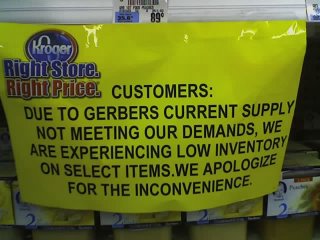No, I don't buy baby food, but happened to stumble down this aisle at the local grocery store. This picture reminds me of Taiichi Ohno being inspired by the ready availability of goods at an American supermarket and that being the basis of pull systems. In this case, Kroger is squarely blaming Gerbers for a short supply (the shelves looked pretty full to me). I wonder if that was an excuse or reality?
In their new book, Lean Solutions, Womack and Jones claim that the “typical level of service… for individual items on the shelves in the right place is about 92 percent.” This means, for a typical shopping trip of 40 items, you are only 4% likely that all 40 goods will be available and you go home less than satisfied. Is that really true? Shouldn't we expect to see more signs like this? What are your experiences, at the supermarket and the factory?
What do you think? Please scroll down (or click) to post a comment. Or please share the post with your thoughts on LinkedIn – and follow me or connect with me there.
Did you like this post? Make sure you don't miss a post or podcast — Subscribe to get notified about posts via email daily or weekly.
Check out my latest book, The Mistakes That Make Us: Cultivating a Culture of Learning and Innovation:









